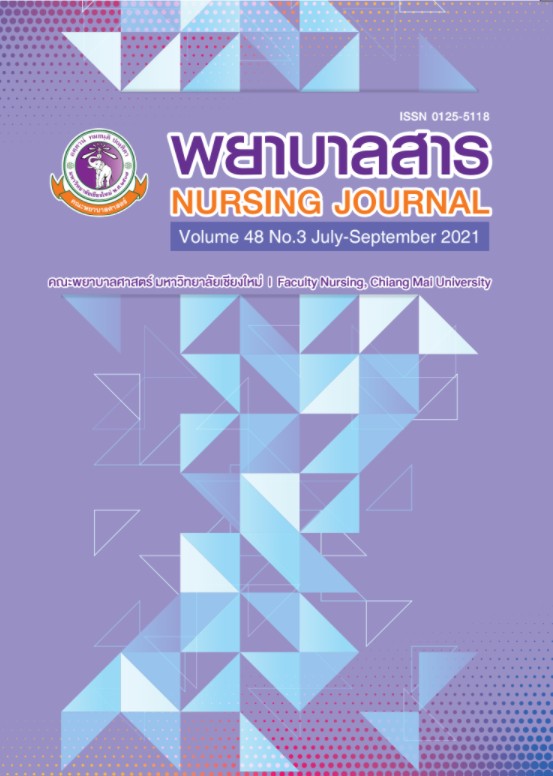Factors Related to Fear of Childbirth in Expectant Fathers Having High Risk Pregnant Wives
Keywords:
Fear of childbirth in expectant fathers, , anxiety, social support, self-esteem, family incomeAbstract
Fear of childbirth in expectant fathers can occur from negative predictions about pregnancy and childbirth of their wives and caring for their babies in the future. The purpose of this descriptive correlational research study was to explore paternal fear of childbirth and the correlation of this fear with anxiety, social support, self-esteem, family income and fear of childbirth in expectant fathers with high risk pregnant wives. The subjects were selected following the inclusion criteria and consisted of 100 expectant fathers who brought their wives to the antenatal clinic at Maharaj NaKorn Chiang Mai Hospital from March to June 2019. The research tools comprised demographic data, the Paternal Fear of Childbirth Scale (P-FOCS) by Sansiriphun et al. (2017), the State-Trait
Anxiety Inventory [STAI] form Y-1 by Spielberger (1976) and the Thai version by Nontasak, Iamsupasit, and Thapinta (1991), the Expectant Father Having High Risk Pregnant Wives Social Support Questionnaire by Neawchalee (2007), and the Self-esteem Visual Analog Scale (SVAS) by Piyavhatkul et al. (2011). Descriptive statistics such as Pearson’s product moment correlation were used to analyze the data.
The results of the study were as follows:
1. Subjects had a mean score for fear of childbirth of 105.54 (S.D. = 37.77), which had either a moderate to severe of fear of childbirth, 42% equivalent.
2. Anxiety had a positively statistically significant correlated with fear of childbirth in expectant fathers having high risk pregnant wives. (r = .621, p < .01).
3. Social support and self-esteem had negatively statistically significant correlated with fear of childbirth in expectant fathers having high risk pregnant wives. (r = -.218, p < .05; r = -.250, p < .05 respectively).
4. There was no correlation between family income and fear of childbirth in expectant fathers with high-risk pregnant wives.
The result of this study can provide basic information to develop effective nursing care plans in nursing practice that reduce the fear of childbirth in expectant fathers with high-risk pregnant wives.
References
Bergstrom, M., Rudman, A., Waldenström, U., & Kieler, H. (2013). Fear of childbirth in expectant fathers, subsequent childbirth experience and impact of antenatal education: Sub analysis of results from a randomized controlled trial. Obstetricia et Gynecologica Scandinavica, 92(8), 967-73.
Chalmers, B., & Meyer, D. (1996). What men say about pregnancy, birth and parenthood. Journal of Psychosomatic Obstetrics and Gynaecology, 17, 47–52.
Cunningham, F.G., Leveno, J. K., Bloom, L. S., Spong, Y. C., Dashe, S. J., Hoffman, L.B., … Sheffield. S. J., (2018). Williams obstetrics (24thed.). Columbus, OH: McGrawHill.
Department of Obstetrics and Gynecology Faculty of Medicine (2017). Maternal-fetal medicine 2017. Chiang Mai University.
Eriksson, C., Westman, G., & Hamberg, K. (2005). Experiential factors associated with childbirth- related fear in Swedish women and men: A population based study. Journal of Psychosomatic Obstetrics & Gynecology, 26(1), 63-72.
Eriksson, C., Westman, G., & Hambreg, K. (2006). Content of childbirth-related fear in Swedish women and men: Analysis of an open-end question. Journal of Midwifery & Women’s health, 51(2), 112-118.
Eriksson, C., Salander, P., & Hamberg, K. (2007). Men’s experiences of intense fear related to childbirth investigated in a Swedish qualitative study. Journal of Men's Health and Gender, 4(4), 409-418.
Finnbogadóttir, H., Svalenius, E. C., & Persson, E. K. (2003). Expectant first-time fathers’ experiences of pregnancy. Midwifery, 19(2), 96-105.
Hanson, S., Hunter, L. P., Bormann, J. R., & Sobo, E. J. (2009). Paternal fears of childbirth: A literature review. The Journal of Perinatal Education, 18(4), 12-20.
House, J. S. (1981). Work stress and social support. New Jersey: Prentice Hall.
Kaewya, P., Sansiriphun, N., Baosoung, C. (2013). Fear of childbirth among first time expectant fathers and related factors. Nursing Journal, 41 (3), 13-23. (in Thai)
Karnjanakaew, A. (2017). Factors related to anxiety of first-time expectant fathers (Master’s thesis). Chiang Mai University, Thailand. (in Thai)
Naechalee, A. (2007). The predictability of personal factors, social support and uncertainty on stress and coping behavior of first-time fathers from high risk pregnancy. Ramathibodi Nursing Journal. 14(2), 243-257. (in Thai)
Nontasak, T., Iamsupasit, S., & Tapinta, D., (1991). Reduction of anxiety of staff nurses working with AIDS patients through cognitive reconstructuring and mindfulness training. Nursing Journal, 19 (2), 1-10.
Piyavhatkul, N., Aroonpongpaisal, S., Patjanasoontorn, N., Rongbutsri, S., Maneeganondh, S., &
Pimpanit, W. (2011). Validity and reliability of the Rosenberg self-esteem scale Thai version as compared to the self-esteem visual analog scale. Journal of the Medical Association of Thailand Chotmaihet Thangphaet, 94(7), 857-62. (in Thai)
Premberg, A., & Lundgren, I. (2006). Fathers' experiences of childbirth education. The Journal of Perinatal Education, 15(2), 21-28.
Rosenberg, M. (1989). Society and the adolescent self-image (Rev. ed.). Princeton: Princeton University Press.
Saisto, T., Salmela-Aro, K., Nurmi, J. E., Halmesmaki, E. (2001). Psychosocial characteristic of woman and their partners fearing vaginal childbirth. British of Obstetrics and Gynaecology, 108, 492- 498.
Sansiriphun, N. (2009). Becoming a firth time father among Thais (Unpublished doctor Dissertation). Chang Mai University, Thailand. (in Thai)
Sansiriphun, N. (2018). Factors predicting paternal fear of childbirth among Thais. Journal of Psychosomatic Obstetric Gynaecology. Manuscript submitted for publication.
Sansiriphun, N., Baosoung, C., Soivong, P., & Sangkhum, N. (2017). Development of paternal fear of childbirth scale. Nursing Journal, 44 (2), 34-45. (in Thai)
Spielberger, C. D. (1976). The nature and measurement of anxiety. In C. D. Spielberger, & R. Diaz-Guerrero (Eds), Cross – cultural anxiety (pp. 3-12). Washington, DC: Hemisphere.
Spielberger, C. D., & Sydeman, S. J. (1994) State-Trait anxiety inventory and State-Trait anger expression inventory. In M. E. Marvish (Ed.). The use of phychological test for treatment planning and outcome assessment (pp.292-321). Hillsdate: LEA.
Srisathitnarakul, B. (2010). The methodology in nursing research. Bangkok: U&I Intermedia.
Szeverenyi, P., Poka, R., Hetey, M., & Torok, Z. (1998). Contents of childbirth-related fear among couples wishing the partner’s presence at delivery. Journal of Psychosomatic Obstetric Gynaecology, 19(1), 38-43.
Downloads
Published
How to Cite
Issue
Section
License
บทความที่ได้รับการตีพิมพ์เป็นลิขสิทธิ์ของวารสารพยาบาลสาร
ข้อความที่ปรากฏในบทความแต่ละเรื่องในวารสารวิชาการเล่มนี้เป็นความคิดเห็นส่วนตัวของผู้เขียนแต่ละท่านไม่เกี่ยวข้องกับมหาวิทยาลัยเชียงใหม่ และคณาจารย์ท่านอื่นๆในมหาวิทยาลัยฯ แต่อย่างใด ความรับผิดชอบองค์ประกอบทั้งหมดของบทความแต่ละเรื่องเป็นของผู้เขียนแต่ละท่าน หากมีความผิดพลาดใด ๆ ผู้เขียนแต่ละท่านจะรับผิดชอบบทความของตนเองแต่ผู้เดียว






